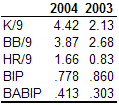Rodney to be Tommy John’d
I know this is old news at this point, but Fernando Rodney is out for the year. After originally being diagnosed with a sprained ligament in the spring, the Tigers medical staff hoped things would work out with rehab. Unfortunately the pain persisted and he was sent for a consult to Dr. James Andrews who deemed Tommy John surgery to be necessary.
This could be a big blow to Rodney’s career. While pitchers return from Tommy John surgery and regain their old form, Rodney was already on the old side of being a prospect. He turned 27 this year, and now he’s missing a full season of activity.
This makes the Ugueth Urbina signing even more attractive. While is was widely believed that the Tigers would look to deal Urbina come the trade deadline, that becomes less likely without another closer on the horizon.
I’d imagine that Rodney will be moved from the 15 day DL to the 60 day DL which would allow the Tigers to add another player to the 40 man roster.
Tigers trade Jon Connolly
In a classic Dave Dombrowski trade, the Tigers a hard throwing lefty. Baseball America has this to say about Felix Sanchez:
Despite Connolly’s sub 2 ERA last year, nobody was really sold on his status as a prospect. He throws soft, and his biggest strengths are his change up and pinpoint control. He also didn’t strike out many guys at West Michigan last year.
The Tigers also included a PTBNL in the deal.
I have no strong feelings one way or the other on this deal. While Connolly’s performance last year was very impressive, I don’t know how sustainable it would be at higher levels and he’s probably still 2-3 years away from the majors (if he makes it that far). Sanchez is closer to being a big leaguer, in fact he had a cup of coffee with the Cubs last year. However, he has control issues and he doesn’t have an overwhelming strike out rate.
Sanchez was assigned to Erie and placed on the 40 man roster. I’m not sure if there was a spot open, but I can’t seem to find who was taken off to make room.
Tigers get thumped
I didn’t see the game, but caught the majority on the radio and it didn’t sound pretty. The 8 run fourth sounded like it was set up with fielding gaffes and bad bounces. Despite that, there were still a ton of hits that inning as well.
The Tigers will welcome in Seattle to close out the month. Tomorrow morning I’ll have a month in review post similar to what I did last year. I’ll follow the same format, except that I’ll be writing about a winning Tiger team for the first time!
